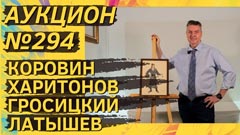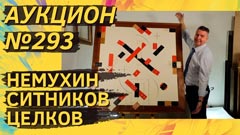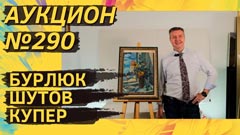
1960s UNOFFICIAL ART
ZVEREV Anatoly Timofeevich (1931–1986) Don Quixote. 1971. Cardboard, oil, scratching. 47 × 60
One of the most beautiful works of the series “Don Quixote” by Anatoly Zverev. And of course, one of the most polysemantic and long-suffering subjects of the “Russian Picasso”. We have already sold several works from the “Don Quixote” cycle. Therefore, collectors have heard more than once, that the “knight of the rueful countenance” is the alter ego of Zverev himself. The artist deeply felt and experienced the insecurity described by Cervantes, the ridicule and hostility of pragmatic society to which sincere dreamers are condemned.
KULAKOV Mikhail Alekseevich (1933–2015) Blossoming. 1960. Cardboard, nitro enamel. 64.5 × 88
The painting “Blossoming” is a real find for collectors. Connoisseurs will immediately notice that this work by the sixties artist Mikhail Kulakov is similar to the nitro enamels of another famous St. Petersburg avant-garde artist Evgeny Mikhnov-Voitenko. And they hit the spot. The painting belongs to the most valuable innovative period, when Kulakov and Mikhnov-Voitenko together experimented with nitro enamels. At one time they even shared a workshop, which then burned down.
Let us remind you that Mikhail Kulakov was a sixties innovator of abstract expressionism. He emigrated to Italy in 1976, so his name dropped out of mention in his homeland for many years. But in 2008, after an exhibition in the Tretyakov Gallery, his art has been rediscovered by many Russian collectors. Before us is a work of undoubted museum level. A rare chance for visionaries.
KOLEICHUK Vyacheslav Fomich (1941–2018) Möbius. 1973–1998. Metal, wood. 143 × 50 × 15
The Möbius ribbon is a paradoxical geometric object that has a one-sided surface. It was noticed, described and presented to the scientific community by the German mathematician and astronomer August Ferdinand Möbius in the 19th century. This figure was found as early as the third century AD in Roman mosaics and in thirteenth century Arabic engineering drawings. But it was Möbius who drew attention to the phenomenon. According to legend, his maid Martha made a mistake, sewing a strip of cloth incorrectly, and this prompted Möbius' discovery. Two surfaces, but one side! If you take a pen and draw the strip along the ribbon, the rod comes out at the same point where you started to draw the line. Today, the Möbius strip is widely used in belt drives because the belt wears evenly on both sides. And of course, the beautiful concept attracted the attention of the kineticists, once united by Lev Nusberg in the group “Movement”. In the late 1960s, it included Francisco Infante, Aleksandr Efimovich Grigoriev and, of course, Vyacheslav Koleichuk. These ambitious young artists, who considered themselves the heirs of Tatlin and Calder, created impossible geometrical structures and terrified the mastodons of socialist realism. Today Vyacheslav Koleichuk is one of the most expensive and recognized artists of the direction. And his “Möbiuses” and other “impossible objects” are mainstream works in his art. This particular “Möbius” participated in the exhibition “Crossing the space” a year ago and was published in the exhibition catalogue. There is an inscription of the artist's daughter on the base, confirming the authenticity of the sculpture.
TSELKOV Oleg Nikolaevich (1934–2021) Square plate. 2009. Porcelain, overglaze painting. 43 × 43
A limited edition and rare item at the same time. There are only 25 such large square plates in the whole world. This is the third copy. The plate of this cycle can be seen on pg. 60 in the catalogue “Porcelain of the Sixties”.
Grotesque muzzle characters appeared in the work of Tselkov back in the 1960s, and since then he has not left his main theme. Like Zverev's Don Quixotes, Tselkov's “faces” are a metaphorical depiction of representatives of society. Only not romantics, but pragmatists who oppose them. Such views could not be professed openly in the USSR. Even if one called the faces “masks”. Tselkov was quickly uncovered and sent out. First they closed the exhibitions on the first day, and then they expelled him from the Union of Artists. Tselkov emigrated in 1977. But he did not disappear or “dissolve” far from his homeland. He was not forgotten, he was remembered, he was recalled while rereading Dovlatov. And today, Tselkov is one of the most expensive and one of the few reference artists for high status collections. In the same line as Krasnopevtsev, Kabakov and others.
BRUSILOVSKY Anatoly Rafailovich (1932) Lenin in Dymkovo. 1978. Paper, ink, collage. 48.5 × 53.5
An exemplary, extremely indicative and amazingly harmonious example of collage graphics by the sixties artist Anatoly Brusilovsky. Brusilovsky was not afraid of bold and frivolous themes. His collages not only carried erotic, but also political overtones. Sometimes on the verge. Not this time, though. Lenin, surrounded by Dymkovo women and goats, is a pronounced conceptualist technique.
And no wonder. Brusilovsky is a representative of Moscow conceptualism, a member of the conditional group of Sretensky Boulevard. He is not only an artist, but also an effective organizer of artistic life. In particular, Brusilovsky organized the first session of body art in the USSR. And Brusilovsky is also the artist who wrote the book “Studio”, which has become for many collectors a window into the world of the Sixties.
Please note that in terms of subject matter and time of creation the collage “Lenin in Dymkovo” refers to a particularly valuable period. The height of stagnation. 1978. And Lenin is dreaming. Sitting and playing with toys.
CONTEMPORARY ART
SAVKO Alexander Andreevich (1957) How is life, heroes? 2021. Acrylic on canvas. 112 × 75
Alexander Savko is the face of modern Russian conceptualist palimpsest. His artistic technique is the reinterpretation of well-known works of art. Transferring prim classics to the absurdist reality. In this field the artist has no authorities and “red lines”. For which he has suffered several times. In particular, Savko is one of the first artists to be prosecuted “for insulting religious feelings”.
And what do we have today? The first layer of the painting “How is life, heroes?” is the subject of the painting “Chelyabinsk” by artist Vasily Neyasov, painted in 1979. A student of Fedot Sychkov, staying within the boundaries of the harsh style of Socialist Realism, he created a ruthless piece. Chelyabinsk is the forge of the Urals. Industrial pride. 1979 — this is as planned, the era of developed socialism. And what do we see in the picture? Rugged faces. Knee-deep mud. People in waders. Poor clothes. A miserable life around, and cabbage in the canteen. It does not look like a fairy tale.
But Savko switches this plot from a social and domestic critique to a critique of modern self-presentation and the crisis of communicativeness. In front of the city's canteen, the weirdo spidermen have gathered. Lots of them. That's not the way it works. Obviously, they are fake. But every year it becomes more and more difficult to distinguish who is who. Times are such that everyone's pretending to be a superhero. That's the rules of the game. The only salvation is that for every superhero, there's a Joker in time of need. And here he is, standing on the sidelines, squinting. When it comes down to it, we'll see who's who.
- Log in to post comments










